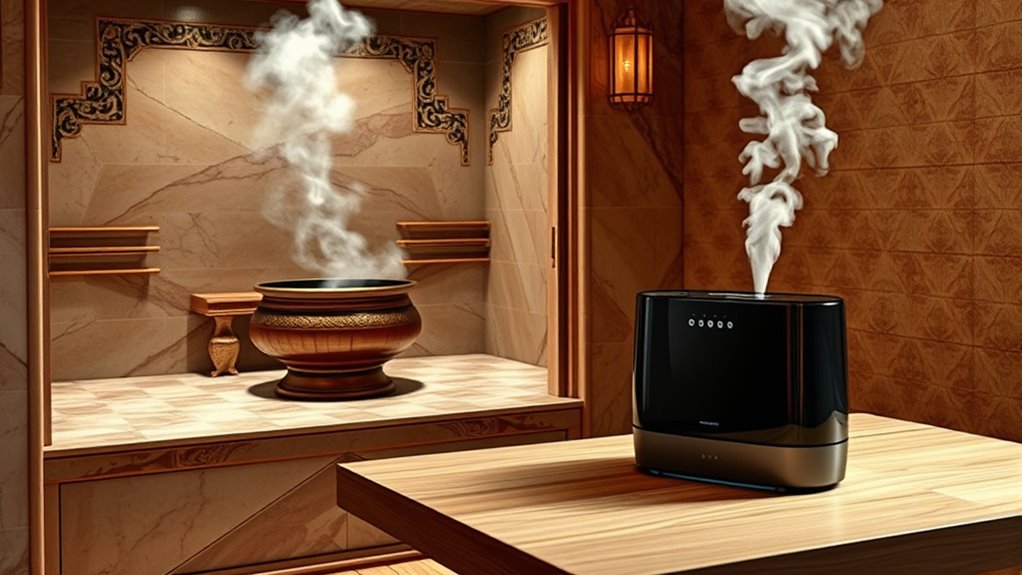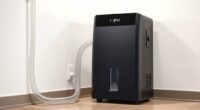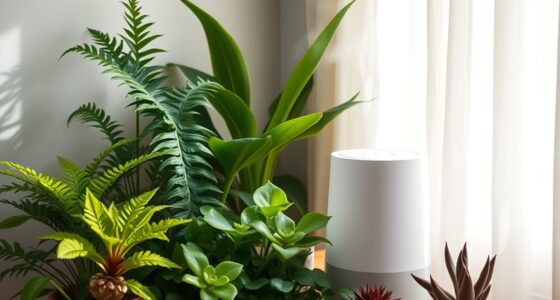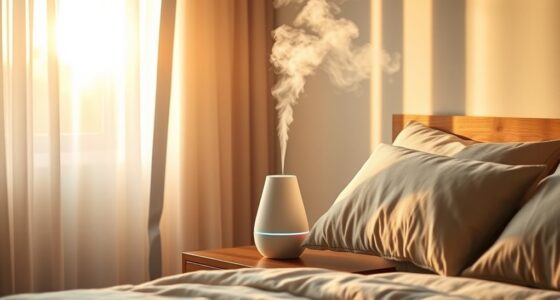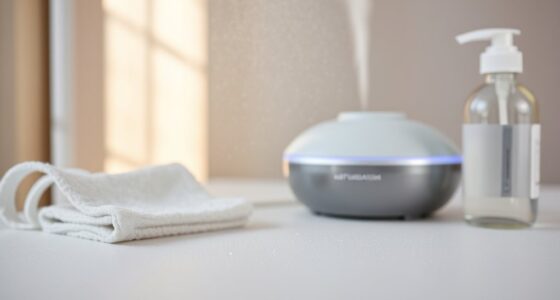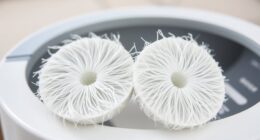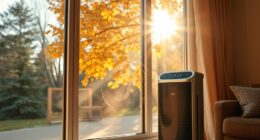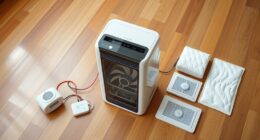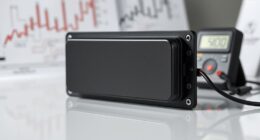Humidifiers have a long history, starting with ancient Roman baths and natural misting techniques used to keep air moist and promote comfort. Over time, people developed more systematic methods, especially during the Industrial Revolution, with steam and water spray systems. Today, advanced devices like smart humidifiers automatically control moisture levels for health and convenience. Curious about how these innovations shaped your modern environment? Stay with us to explore this fascinating evolution further.
Key Takeaways
- Ancient humidification utilized natural resources like hot springs and sprinklers to create mist for comfort and health.
- Romans advanced humidification with large basins and heated environments in baths and saunas.
- The Industrial Revolution introduced steam and water spray systems for controlled indoor moisture in factories.
- Modern humidifiers evolved from basic misting to smart, automated devices using ultrasonic and evaporative technologies.
- Today’s humidifiers are integrated into home automation, offering efficient, health-focused indoor air quality management.
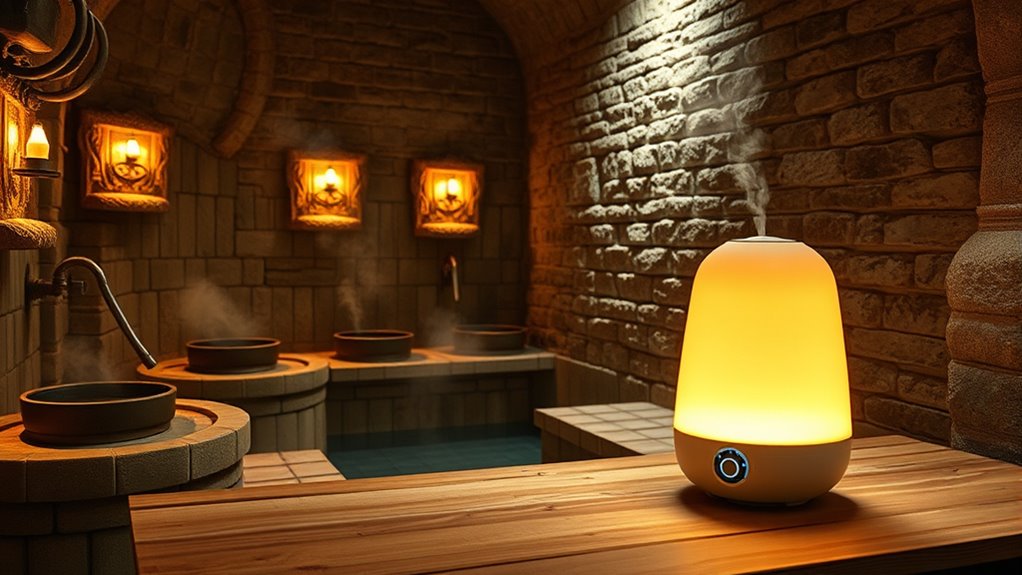
Have you ever wondered how humans have managed to add moisture to the air long before modern devices? Throughout history, people have used innovative methods to combat dry environments, especially when comfort or health was at stake. One of the earliest techniques is ancient misting, where simple tools and natural resources were used to produce a fine spray of water into the air. In ancient times, hot springs and baths, like those in Roman saunas, played a crucial role in maintaining humidity. Romans understood that moist air made their baths more comfortable and helped soothe their skin, so they used large basins and sprinklers to release a gentle mist over heated rooms. This was an early form of humidification, blending comfort with practical health benefits. Their approach was quite effective, even though it wasn’t the high-tech humidifier we know today.
As centuries passed, the concept of industrial humidification emerged, especially during the Industrial Revolution. Factories and textile mills faced the challenge of controlling air quality and moisture levels to improve product quality and worker health. They developed more systematic methods to add moisture to the air, utilizing steam and water spray systems. These early industrial humidifiers were large, often requiring significant infrastructure, but they marked a major step forward in managing indoor humidity on a larger scale. These devices not only protected delicate fabrics and machinery from dryness but also created more comfortable working environments. Their development exemplifies how humidification evolved from simple, natural techniques into engineering solutions designed for efficiency and scale.
Fast forward to today, where humidifier technology has advanced dramatically. What once involved basic misting or steam is now sophisticated, smart devices that can be controlled remotely and integrated into home automation systems. Modern humidifiers use ultrasonic vibrations or evaporative methods to produce a fine, consistent mist, ensuring ideal moisture levels with minimal effort. They can even monitor room humidity levels automatically, adjusting output as needed to maintain comfort and health. The journey from ancient misting in Roman baths to today’s smart devices reflects how human ingenuity has continuously improved the way we manage indoor air quality. Whether through natural methods or cutting-edge technology, the goal remains the same: creating a healthier, more comfortable environment by controlling moisture in the air.
Frequently Asked Questions
How Do Humidifiers Affect Indoor Air Quality?
Humidifiers improve your indoor air quality by adding moisture, which helps reduce airborne pathogens and alleviate respiratory issues. Properly maintained, they can prevent mold growth caused by overly dry air, making your environment healthier. However, if not cleaned regularly, humidifiers can become breeding grounds for bacteria and mold, potentially worsening air quality. So, keep your device clean and at ideal humidity levels to enjoy cleaner, healthier indoor air.
Are There Health Risks Associated With Humidifier Use?
Did you know that improperly maintained humidifiers can cause health issues in 30% of users? Yes, there are risks like mold growth and bacteria spreading if humidity regulation isn’t managed properly. You might experience allergy symptoms or respiratory problems. To stay safe, clean your humidifier regularly, use distilled water, and monitor indoor humidity levels to prevent mold and guarantee healthy air quality.
What Are the Environmental Impacts of Modern Humidifiers?
You might wonder about the environmental impacts of modern humidifiers. They can consume significant energy, especially models with advanced features, increasing your carbon footprint. Some humidifiers also release chemical emissions from disinfectants or additives, which can harm indoor air quality and contribute to pollution. To minimize these impacts, choose energy-efficient devices, avoid unnecessary chemical use, and maintain your humidifier properly to reduce emissions and energy consumption.
How Do Different Humidifier Types Compare in Efficiency?
When comparing humidifier types, you’ll find evaporative models often excel in efficiency, using natural evaporation to add moisture effectively with minimal energy. Ultrasonic humidifiers, on the other hand, deliver fine mist quickly and quietly, providing excellent ultrasonic performance. Depending on your needs, evaporative units might save energy, while ultrasonic ones offer rapid, targeted humidification. Choosing the right type depends on balancing evaporative efficiency and ultrasonic performance for your space.
Can Humidifiers Help With Specific Medical Conditions?
Humidifiers can offer medicinal benefits, especially for conditions like dry skin, sinus congestion, or respiratory issues. You might find relief from allergy symptoms and nasal irritation as they add moisture to the air. By maintaining ideal humidity levels, humidifiers help soothe your airways, making breathing easier. They’re especially beneficial during dry seasons or in heated environments, providing targeted allergy relief and improving overall comfort.
Conclusion
As you explore the history of humidifiers, remember they’re like silent guardians, quietly evolving from Roman saunas to smart devices. Each innovation has added a new brushstroke to their story, shaping a world where comfort and health blend seamlessly. Just as a gentle mist refreshes a garden, modern humidifiers refresh your living space. Embrace this journey, knowing you’re part of a timeless dance—balancing moisture and well-being, one drop at a time.
